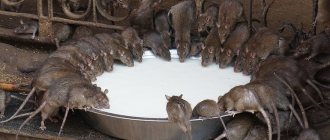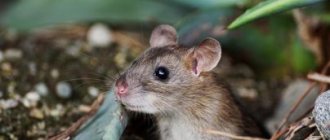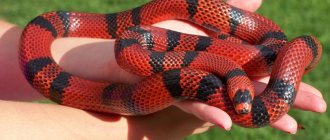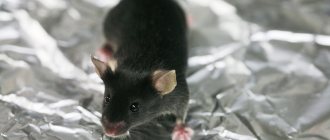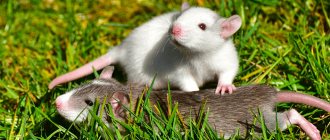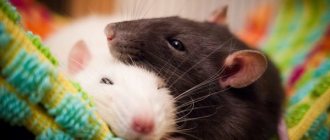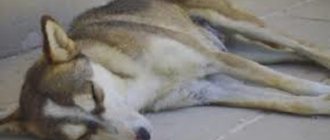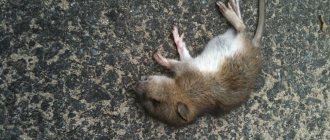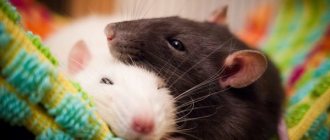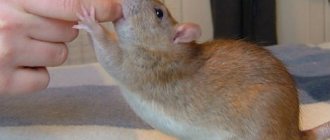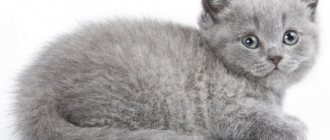Mice are small animals belonging to the class of mammals, an order of rodents from the mouse family.
They are found everywhere. The vast majority of their species live in tropical and subtropical forests, with fewer in the temperate and northern latitudes of Europe and Asia, as well as on the Australian mainland. There are approximately 13 species of mice common in the Russian Federation.
In total, the mouse family list includes 147 genera and 700 species. The size of the animal ranges from 5-48 cm, depending on the type of animal.
Below in the article we will try to describe what types of mice there are, how many species of them are found in Russia, what types of mice live where, and also provide their names, descriptions and photos.
Baby mice
They are one of the smallest rodents on earth. The size of an adult does not exceed 7 cm, the tail - 6-7 cm. The baby weighs no more than 10 g.
The appearance of the animal, namely its coloring, distinguishes it from other species. The fur of these mice is bright red in color, except for the abdomen, which is almost white.
Habitat: Spain, Korea, Japan, southern Kazakhstan, China and northern Mongolia. They are found in forests, fields and forest-steppe. In the summer they build nests in the grass, and in the winter they move into burrows, haystacks, and human dwellings.
Baby mice quickly adapt to their new environment. They are quite peaceful and calm. They can live in captivity. At the same time, the animals need a large, capacious cage or a small terrarium so that the little ones can move and climb freely.
In food, it prefers seeds, cereals, legumes, and small insects.
Interpretation of human actions in a dream
After sleep, a person tries to reconstruct the dreamed events in detail. Usually he remembers perfectly how he acted in a situation. His decisive actions against black mice are interpreted as follows:
- set a mousetrap - someone is manipulating and making plans against;
- caught mice - became a participant in someone’s intrigue;
- killed - defeated all enemies;
- fed - someone close to you needs financial help;
- got scared and screamed - unexpected unpleasant news.
It’s good to see in a dream how a cat deals with a black mouse. This means that true friends and loving people will come to the rescue.
Dreams come to a person for a reason. This is another way of the subconscious to influence actions. Interpretation of dreams will help you avoid problems. Or adequately prepare for them.
House mouse
The ability to get along with humans has made these animals the most common species of the mouse family and the most numerous of the mammals on earth. Distributed everywhere. The Far North, Antarctica, and highlands are places where these rodents are absent due to low temperatures and high humidity.
These mice are perhaps the smallest representatives of their family, if you do not take into account the tiny mice. The length of their body is no more than 10 cm, the tail is 5-10 cm. The animal has gray fur on its back, sides and a light belly. House mice that live in desert areas are sandy yellow in color, while domesticated house mice are white.
Unlike wild rodents, white decorative mice often become pets. In addition, they are bred in laboratory conditions as food for serpentarium pets, as well as for clinical studies as experimental animals.
In nature, rodents live in burrows. With the onset of autumn, they begin to move into residential buildings and outbuildings.
The main diet is seeds, grain, green parts of plants, and once in a person’s home, they sweep away everything that comes their way - from bread crumbs to soap and candles.
General characteristics of mouse representatives
The mouse family is diverse. Mice are omnivores and herbivores. Some were bred artificially so that they could be kept as pets. Habitat: all continents. The only place on the planet where mice are not found is Antarctica and mountain slopes.
Distinctive features of the appearance of mice are:
- length up to 10 cm (rare species up to 12 cm);
- fur along the entire length of the body;
- triangular muzzle;
- The ears are round, large, sticking out in different directions.
It is impossible to confuse mice with other rodents, since their size is too small. The color of the animal is varied, and only albinos have red eyes. The rest of the breeds have small black eyes.
All types of mice are fertile. Throughout the year, a sexually mature female brings up to 8–10 litters. But life expectancy does not exceed 5 years. Each litter contains from 5 to 8 mice. The duration of gestation is 21 days.
Young mice are born blind, without fur. Over the course of 14–21 days, the pups become similar to adults, but smaller in size. Completely independent, they get their own food.
Interesting fact! Reproduction activity occurs in the summer due to a sufficient amount of food. In autumn the animal is less active. In winter, the female is able to give birth only once.
Harvest mouse
Habitat: Central and Eastern Europe, the southern part of Western Siberia, China (except for the south), Mongolia, the Korean Peninsula, Taiwan. This type of rodent rarely lives in houses and outbuildings, unlike house mice.
The field mouse prefers open areas - bushes and fields. In megacities it mainly lives in green zones. Lives both in burrows and other natural shelters. Rodents that live in swampy areas build nests in bushes or grass.
The body length of the animal can reach up to 12.5 cm, the tail – up to 9 cm. The color of the field mouse is grayish-brown, with a dark stripe running along the back.
The animal’s diet, which changes depending on temporary conditions, is based on plant foods and insects. Field mice are the largest pests for agriculture and forestry, and they can also live in country houses.
Characteristic features of life
It is believed that mice are quite timid by nature. This may be true, but if the mouse does not behave this way, then it will not survive, since it has a sufficient number of natural enemies.
In the wild, the mouse adapts to various conditions of its existence: it crawls, swims, digs holes in the ground, and some species have learned to fly. Such abilities of such a small mammal allow it to survive in such harsh natural conditions.
A mouse can build its nest anywhere - underground, in the hollows of old trees, in bird nests, under stones, etc. When she settles in a person’s house, her nest can be found under the floor, in the attic, in the basement, in the openings between the walls. The rodent goes hunting at night, but does not go far from its nest. During the daytime, mice sit quietly in their hiding places.
Interesting Facts! Some species of mice live in large packs, where the head of the pack is a male with several females. Each individual is responsible for its own territory, where it obtains food for itself. The offspring are raised by all females together, and after they reach “adulthood”, the young are expelled from the pack.
Mice wait out the winter in different conditions. For example:
- In the ground, in deep holes.
- In hay or straw stacks.
- In outbuildings for various purposes.
Mice that spend the winter in natural conditions store food supplies for the winter. To do this, rodents set aside special places in their burrows where they carry everything that could be useful in winter, just so as not to die of starvation.
Mice have a sufficient number of natural enemies - these are reptiles, hedgehogs, cats, dogs, foxes, as well as other birds of prey and animals.
In nature, a mouse can live no more than a year, although at the genetic level the term is about 5 years. This is due to the fact that this rodent has too many natural enemies. In artificial conditions, rodents live for about 3 years, and in laboratory conditions - 7 years.
Wood mouse
The animal prefers natural shelters, its own or others' burrows in floodplains, in thickets of meadow bushes, and in open areas of forest. Their habitats are broad-leaved and mixed forests of Eastern Europe, Turkey, the Caucasus, Kazakhstan, Altai.
It reaches 10 cm in size. The length of the tail is approximately the same as the length of the body. Color – grayish-red. Some individuals have a yellow spot in the chest area.
Rodents, as a rule, feed on plant foods (grain, seeds), and do not refuse insects. They eat young tree seedlings, causing severe damage to forestry.
Character
House mice are quite shy. At any unexpected noise, the rodent gets scared and runs away. The vision of representatives of the mouse family is quite poor; they see practically nothing at close range. They navigate in space using:
- smells;
- sound;
- whiskers (vibrissae).
At night, the rodent sees practically nothing, so it moves “by touch” with the help of its whiskers. Rodents are very social; they cannot be outside of society for a long time.
The animal also boasts a high speed of movement, which reaches 13 km/h. Rodents, as a rule, move along a predetermined route, which they create using their own excrement. “Mouse tracks” appear in a house or warehouse a very short time after the animal moves into the building.
These animals are carriers of a large number of infectious diseases that are equally dangerous to humans and their pets. Rodents also cause significant damage to interior items that serve them to wear down their teeth, and to the products that they eat and contaminate with waste from their vital activity. It is assumed that the main reason for taming cats in the distant past was precisely the fight against these pests in the house.
Vole mouse
Distinctive features of this type of rodent are their short tail, small ears and small muzzle. The length of the mouse's body, not including the tail, is 12 cm. The color is gray or dark brown, the abdomen is gray.
Habitat: North Africa, Middle East, northern India, southwestern China, Taiwan, Japanese Islands, North America.
Like a mole, the vole digs deep, multi-pass burrows. The animals are active at night and are underground during the day. They feed on plant foods - green parts of plants, roots, tubers.
You can try to fight small rodents using ultrasound.
Natural enemies
Due to their small size, the animals are vulnerable to larger animals. The long-nosed mouse can become a victim of birds of prey, ferrets, weasels, cats, dogs, and foxes. However, predators usually refuse a snack if they smell the peculiar aroma of a shrew.
The enemy of this mouse is also man. People often mistake them for pests and destroy them. But, as practice shows, these animals bring more benefits. Of course, they can damage the root systems of small plants when they dig while chasing their prey.
But at the same time, they perfectly loosen the soil, saturate it with oxygen and fight insects that pose a danger to the crop. They manage to destroy pests in places where even birds are unable to reach them.
How to get rid of mice in the house forever: metal mesh
Biologists say that a mouse will fit even into a hole that would be impossible to insert a pencil into. This is true. The mouse has a very flexible skeleton, and its skull “folds” like that of a baby during childbirth. Therefore, a galvanized mesh to protect against mice must consist of the smallest cells. The second requirement is that it must be made of very durable metal.
The mesh should be made of wire thicker than 2 mm, the cell dimensions should be no larger than 10x10 mm.
The mesh is laid on the subfloor.
They're wrapping her foundation
Or they close the ventilation holes.
All corners are covered with fine mesh (as reinforcement for plaster). It is important not to miss a single corner, not a single joint.
The ventilation gap between the insulation and the sheathing below is also covered with this mesh: you should get a box with walls at least 5 cm high.
Also, a fine-mesh mesh is buried in the ground along the perimeter of the foundation to a depth of 80 cm so that mice cannot dig under it.
To protect against mice, the base is lined with fine-mesh mesh at least a meter in height.
Professionals advise laying fine mesh wherever a mouse could theoretically sneak through.
For additional protection of the base, it is recommended to sheathe it to a height of at least a meter:
- corrugated sheet made of structural steel 1.5 mm thick (in waves lengthwise);
- slippery smooth plastic;
- plaster (but to prevent the mouse from chewing through the plaster, the top is finished with acrylic putty and slippery paint is applied to the putty).
Pregnancy, babies
A pregnant shrew carefully prepares for her litter. She lines her hole with dry leaves and grass to create a fairly soft litter. In May-July, about 6-10 cubs appear. At first the mother looks after them with trepidation and care, but very quickly her love fades. Then the cubs themselves go in search of food.
The shrew is very active and agile - it runs very fast, jumps far and even swims, if necessary. She makes whistling sounds. He has a highly developed sense of smell, but most likely never uses his sight and hearing.
Diet in natural conditions and near humans
Mice prefer plant foods, namely:
- corn;
- seeds;
- nuts;
- roots, stems, leaves and buds of plants;
- vegetables fruits.
They eat mice and insects, larvae, spiders.
Nutrition
The diet of a mouse entering a human home is more varied. Unpretentious animals eat cereals, bread, dairy and meat products, soap, and candles. Even the smallest rodent can cause serious damage by chewing wires, furniture, and books.
Reproduction and offspring
Typically, a female gives birth only 1–2 times during the year, less often – 3. Pregnancy in shrews lasts 2–3 weeks, after which 4 to 14 babies are born.
Both parents are involved in arranging the nest for future babies. They line it with dry grass and leaves. The cubs are born absolutely helpless, but within a month they can begin an independent life.
Reasons for appearance
Why do voles appear in summer cottages? Rodents need food, constant availability of water and heat. All these qualities are possessed by warehouses and basements that are available in the country. Rodents are also able to feast on human supplies located in secluded corners of the kitchen. Paths for pests to pass include: ventilation ducts, open windows and doors, cracks in the floor and walls.
It is very easy to spot a pest in your summer cottage. The main signs of animal activity are the presence of minks and feces throughout the house, in secluded places. Pests also leave their marks everywhere. This is due to the fact that rodents’ teeth grow throughout their lives and need to be sharpened. What does a vole eat? It is common for mice to gnaw the bark of trees and the lower parts of bushes in the winter.
